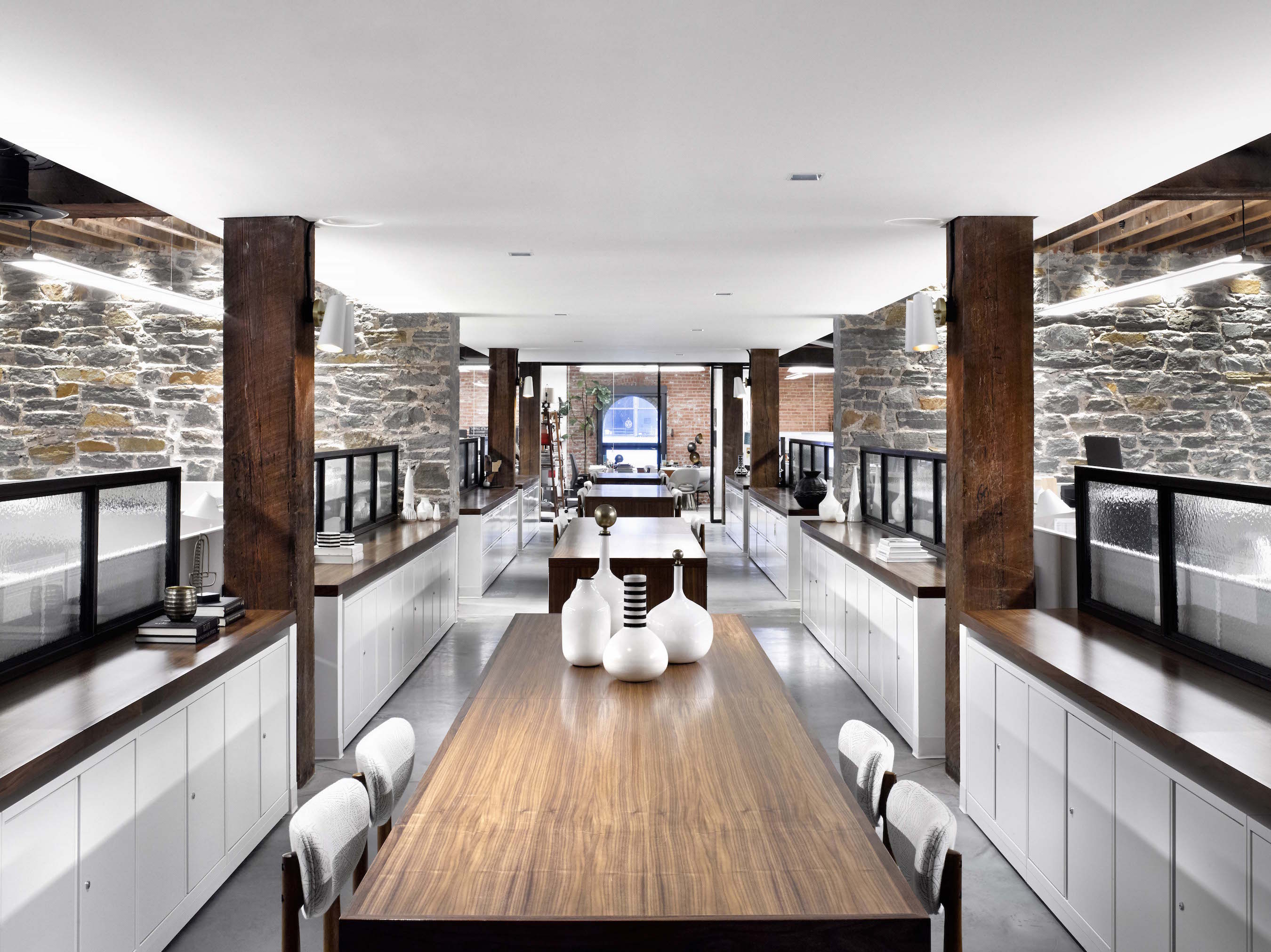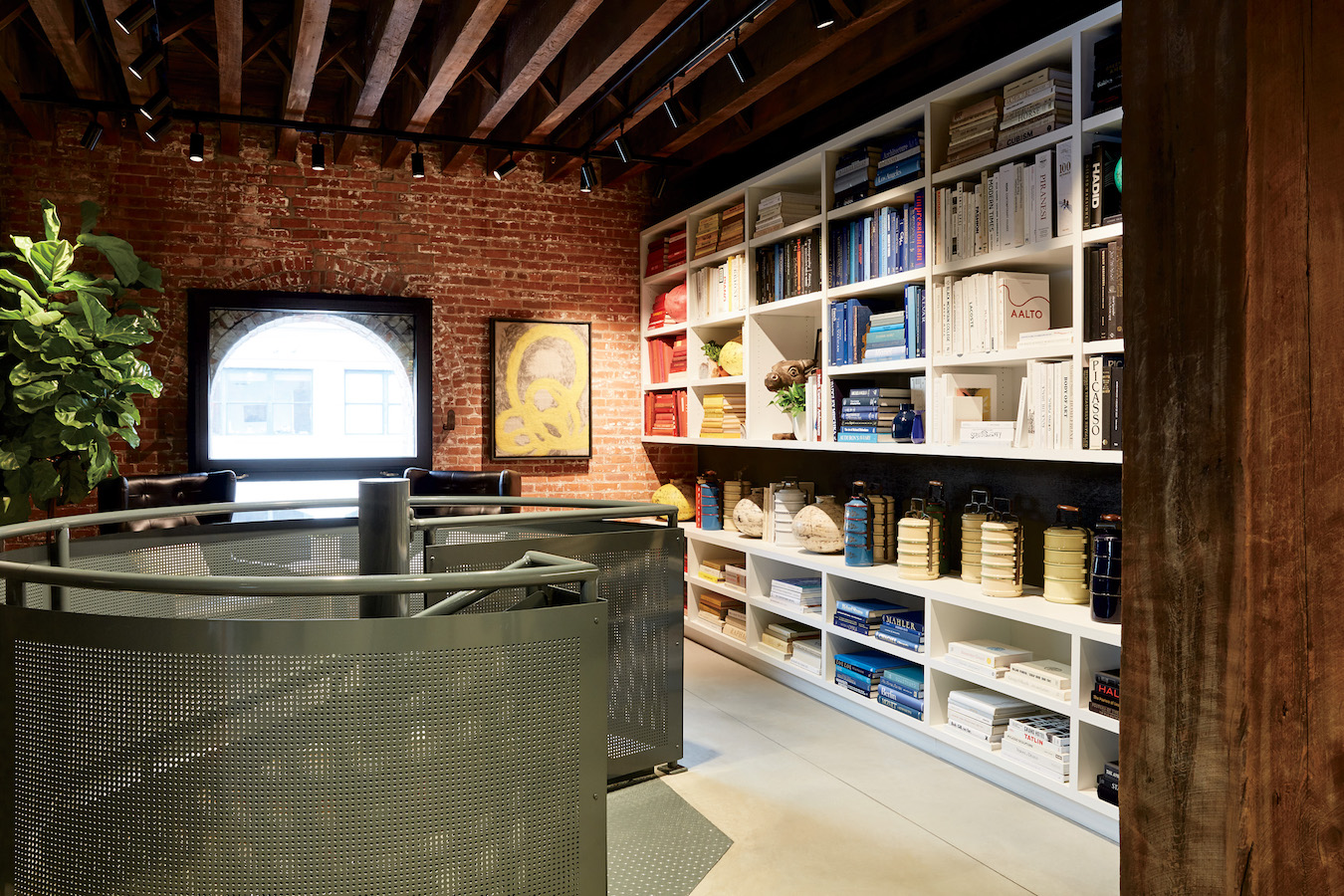
By Lisa Zeiger
When Mark Murashige and Kay Vorderwuelbecke of VM Architecture and Design (VMAD) began redesigning the Empire Stores on the docks of the East River in DUMBO for West Elm in 2013, a high water mark from Hurricane Sandy was still visible, eight feet up the brick walls of the nearly 140-year-old structure, rich with history…

The 300,000 square foot Empire Stores, completed in 1879, and the waterfront property it occupies have been described as ‘the jewel of the Brooklyn waterfront’, ‘the most desirable waterfront property in all of Brooklyn’ and ‘the most iconic structure on the Brooklyn waterfront after the Brooklyn Bridge’.
Nevertheless, as industries shifted, the Stores stood empty for sixty years.
The building is a perfect reflection of the interior architecture of the post-Civil War period in New York. It represents a decisive move away from the Greek Revival style, shifting towards simple facades, rhythmic window openings and large ground level openings for vehicles. These seven newly linked warehouses and commercial buildings, which have the appearance of a single immense fortress, replaced earlier residential buildings as the waterfront gave way to its expanding industry.
There were very sturdy old schist course firewalls between the seven linked brick buildings. During the 19th century, the original warehousemen used huge gallon drums to light warming fires in the building for warmth. Ships would come directly up from the river to the building, which is just 20 feet from the water. Planks slanted up to the windows to load in cargo, mounted on wheels kept inside the building.
The early 2oth century brought about the technique of reinforcing concrete with iron rods which went up faster and protected against fire, a style which is employed in many of the surrounding buildings. The Empire Stores, in contrast, have a red brick exterior marked with signature rows of large arched windows and iron shutters.
The landlord, Midtown Equities, had extensive work to do on the building which had never had plumbing or electricity. To convert the abandoned edifice to working office space with modern codes, restaurants, and retail was an immense undertaking.


Says Murashige, “Nobody but us is aware of many of our design interventions. It was mind-boggling to make the mechanical system appear seamless and invisible, not letting the exposed wood joist ceilings be a cluttered mess of wiring and ducts. It took time, brainpower and energy.”
VMAD had been approached by West Elm during the RFP phase. West Elm had obtained the lease for the building and was to be the major tenant. There followed a year of design and just a year and a half of construction, until August 2016, when West Elm moved in. The masterful scale and detail of the finished building make the three years total of planning, design, and construction seem a surprisingly short time in which to have achieved such quality.

Jim Brett, President of West Elm, lives in DUMBO and made the decision to move not only West Elm’s corporate offices there but also their flagship store. Brett’s ethos for the brand is CHOICE, COMMUNITY, CONSCIOUSNESS; thus his brief for Murashige and Vorderwuelbecke was to recreate the Empire Stores as corporate offices and laboratory for West Elm’s design experimentation in a way that would reflect the company’s mission.

To be in DUMBO, where West Elm grew up as a company, was to reinstate its ties to the neighborhood while augmenting its partnerships with people and companies throughout the world. (Artifacts by such artisans are on display in the corporate offices.)
Murashige and Vorderwuelbecke began interacting with the landlord’s architect in 2013. Shaping the floor plan based on West Elm’s needs, they didn’t yet know what the final design would be. The landlord’s architect was responsible for the historic exterior, common elevators, stairs, roofs, and mechanicals, all of which they executed. As the interior architects for West Elm, VMAD designed the second and third floors. (The fourth and fifth floors are leased to other tenants, and the ground floor West Elm Flagship Store was designed by Callison Architects.)


The building, with its beautiful old timber frame, possesses both the dense woody atmosphere of age and the clarity and spaciousness of VMAD’s modern rethinking of it. When Murashige and Vorderwuelbecke began, there was only raw empty warehouse space, populated by columns, which observers said were too dense a framework to fit in a working environment. Now, when visitors walk through, they don’t even notice the columns, which happen to be configured differently in each of the seven buildings. This variety required the architects to develop different kinds of furniture systems to mesh with the columns.

The architects’ floor plan was governed by the many different uses and activities going on in West Elm’s organization. “Our main task was to create a beautiful office, punctuated by West Elm’s design labs, collaborative spaces, and showroom features showcasing the new West Elm WORKSPACE line,” says Murashige.
The orchestration of the corporate offices was, interestingly, shaped largely by the three office furniture lines VMAD was designing with West Elm. These are designated by the names Modern, Midcentury and Industrial, each line featured in a distinct area of the building, which has become, in effect, a gigantic showroom for these designs, as well as a workspace. Three additional lines were developed with West Elm’s partner Inscape.
The office furniture, based on preexisting West Elm lines, is sold under the name West Elm WORKSPACE by Inscape, the Canadian office furniture company which is collaborating with West Elm. Says Murashige of the WORKSPACE lines, “Architects love designing furniture; one might call it a pleasant fetish! To get a chance to work with west elm, to experiment and develop, and then have the designs actually produced was a great opportunity.”
VMAD sought to create an open plan, yet with separate workspaces that would be surpassingly pleasant, with glassed-in conference rooms named after Brooklyn neighborhoods: Cobble Hill, Sunset Park, and Fort Greene, among others. ![]()
Small blocks of the specially designed office furniture create variegated spaces, linked, in turn, by the corridors, carpeting in subtly changing colors, and the white ceilings. Shifts in color and furniture define, in an understated way, who is working where and their various kinds of responsibilities.

There is a multitude of separate development studios and design labs – for decorative accessories, furniture, lighting — all culminating in a big mock store on the second floor, where you are likely to see a Christmas display, for example, in the spring or summer. West Elm plans ahead and works fast; their design concepts and colors are driven by fashion. (The walls of their textile design labs are covered with fashion tear sheets.) The West Elm library is the concept room, the place where everything really begins, not so much a collection of books, although there are many, but a repository as well of samples drawn from around the globe.

For both Murashige and Vorderwuelbecke, the crowning glory of their vast project is an unexpected one: the so-called ‘Bridge’, a casually elegant, elongated seating area overlooking the stunning DUMBO seascape. All day long members of the West Elm workforce sit there and work. As a place, the Bridge provides both privacy for one’s own thoughts and inspirations, and community, through physical proximity to other people. When I sat there, the close-up, vast, meditative expanse of the water seen from a long bank of windows made me think of the top of the stairs at Grand Central, and the Rose Reading Room of the New York Public Library’s Main Branch, both of them ennobling places which include the visitor in something wonderful. The Bridge, like these, is an epic man-made space.
The aura of West Elm’s DUMBO headquarters kept bringing me back to the company’s slogan: CHOICE, CONSCIOUSNESS, COMMUNITY. While ‘consciousness’ would seem to refer to West Elm’s quest for eco-friendly and fair business policies, it also alludes to the awareness and peace of mind cultivated by its signature building wherein so many individuals work each day. “The corporate and creative workings of West Elm as a company mirror its slogan,” says Murashige.
Witnessing its workings for a morning, I concluded that West Elm DUMBO offers a Utopian vision of labor made real, palpable and pleasant. The superlative design, materials, and character of the building and its furnishings give the often-used oxymoron “corporate culture” a better name, for they embody – in brick, wood, and steel — the humanistic and humanizing values so often absent from the contemporary workplace.
We are reminded that William Morris, the Utopian designer and democratizer of beautiful furniture and houses, founded the Society for the Preservation of Ancient Buildings in 1877, just two years before the completion of the original Empire Stores. In SPAB’s Manifesto, Morris noted that often more harm than good was inflicted on old buildings through architectural restoration and that such buildings should be repaired, not restored, in order to preserve valuable material and cultural traces of their long history.
Instinct and eyesight tell me that Morris would heartily have approved Murashige’s and Vorderwuelbecke’s inspired adaptation–”instructive and venerable”–of the Empire Stores to West Elm’s very contemporary design practice and ethos.
Incredible work done by two incredible architects! The designs of each space are
masterful .
I have had the thrill of visiting some of sites
mentioned here and they are amazing!
The newly designed store in Manhattan is also so praiseworthy…….such a pleasure to simply walk into.